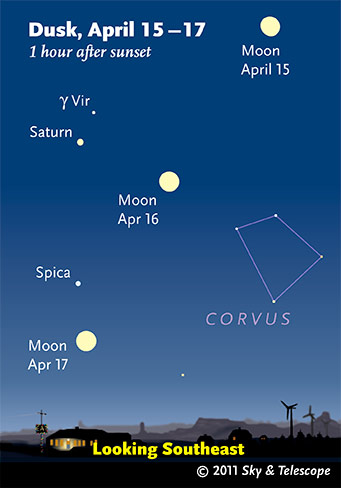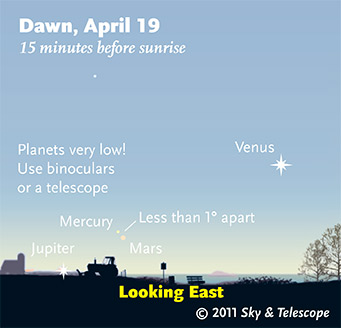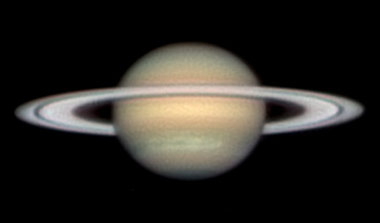Alert: T Pyxidis has finally blown up! The recurrent nova T Pyxidis, which had its last outburst in December 1966 and has been very overdue for its next, has shot up from magnitude 15.4 to at least 8.5. In 1966–67 it reached 6.5. Read more about the ouburst of T Pyxidis.

As the Moon waxes to full, it teams up with Saturn in the evening sky.
Sky & Telescope diagram
Friday, April 15
Saturday, April 16
Sunday, April 17
Monday, April 18

Planets shortly before sunrise. Their visibility in bright dawn is exaggerated here.
Sky & Telescope diagram
Tuesday, April 19
Wednesday, April 20
Thursday, April 21
Friday, April 22
Saturday, April 23
Sky at a Glance is now a free smartphone app! Put S&T SkyWeek on any Apple or Droid mobile device and get the above listings anytime, anywhere — with interactive sky maps! Tap a button to see the scene described, customized for your location worldwide. From there you can scroll the view all around the sky, zoom in or out, change to any time or date, and turn on animation. For free!
Want to become a better amateur astronomer? Learn your way around the constellations. They're the key to locating everything fainter and deeper to hunt with binoculars or a telescope.
For an easy-to-use constellation guide covering the whole evening sky, use the big monthly map in the center of each issue of Sky & Telescope, the essential magazine of astronomy. Or download our free Getting Started in Astronomy booklet (which only has bimonthly maps).

The Pocket Sky Atlas plots 30,796 stars to magnitude 7.6 — which may sound like a lot, but that's less than one star in an entire telescopic field of view, on average. By comparison, Sky Atlas 2000.0 plots 81,312 stars to magnitude 8.5, typically one or two stars per telescopic field. Both atlases include many hundreds of deep-sky targets — galaxies, star clusters, and nebulae — to hunt among the stars.
Sky & Telescope
Once you get a telescope, to put it to good use you must have a detailed, large-scale sky atlas (set of charts). The standards are the Pocket Sky Atlas, which shows stars to magnitude 7.6; the larger Sky Atlas 2000.0 (stars to magnitude 8.5); and the even larger and deeper Uranometria 2000.0 (stars to magnitude 9.75). And read how to use sky charts effectively.
You'll also want a good deep-sky guidebook, such as Sky Atlas 2000.0 Companion by Strong and Sinnott, or the more detailed and descriptive Night Sky Observer's Guide by Kepple and Sanner, or the classic if dated Burnham's Celestial Handbook.
Can a computerized telescope take their place? I don't think so — not for beginners, anyway, and especially not on mounts that are less than top-quality mechanically. As Terence Dickinson and Alan Dyer say in their Backyard Astronomer's Guide, "A full appreciation of the universe cannot come without developing the skills to find things in the sky and understanding how the sky works. This knowledge comes only by spending time under the stars with star maps in hand."
This Week's Planet Roundup
Mercury, Mars, and Jupiter are buried deep in the glare of sunrise (well to the lower left of Venus).
Venus (magnitude –3.9) is visible very low in bright dawn. Look for it above the eastern horizon about 30 minutes before your local sunrise time.

Saturn at opposition on the night of April 3–4. The rings are especially bright compared to the globe due to the opposition effect (Seeliger effect). Christopher Go shot this image at
Alan MacRobert
Saturn (magnitude +0.4, in Virgo) is the only planet now in good view. After passing through opposition on April 3rd, it glows low in the east-southeast as the stars come out. Saturn rises higher in the southeast during evening and shines highest in the south around 11 or midnight. Look for twinkly Spica 12° below it or to its lower left. Don't confuse Saturn with brighter Arcturus 30° to its left or upper left.
In a telescope, the rings have narrowed slightly in the last few months to 8° from edge on. See how many of Saturn's satellites you can identify in your scope using our Saturn's Moons tracker. Saturn's months-old northern-hemisphere white spot is now a much-faded double light band most of the way around the planet, as seen here.
Uranus and Neptune are low in the glow of dawn.
All descriptions that relate to your horizon — including the words up, down, right, and left — are written for the world's mid-northern latitudes. Descriptions that also depend on longitude (mainly Moon positions) are for North America. Eastern Daylight Time (EDT) equals Universal Time (also known as UT, UTC, or GMT) minus 4 hours.
To be sure to get the current Sky at a Glance, bookmark this URL:
http://SkyandTelescope.com/observing/ataglance?1=1
If pictures fail to load, refresh the page. If they still fail to load, change the 1 at the end of the URL to any other character and try again.
 0
0
Comments
You must be logged in to post a comment.